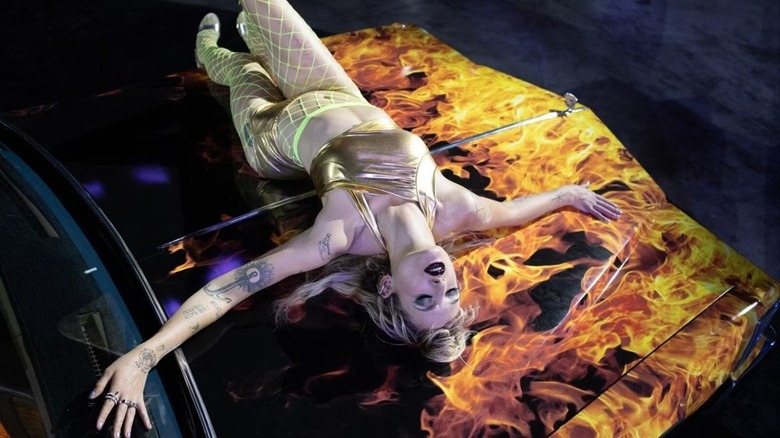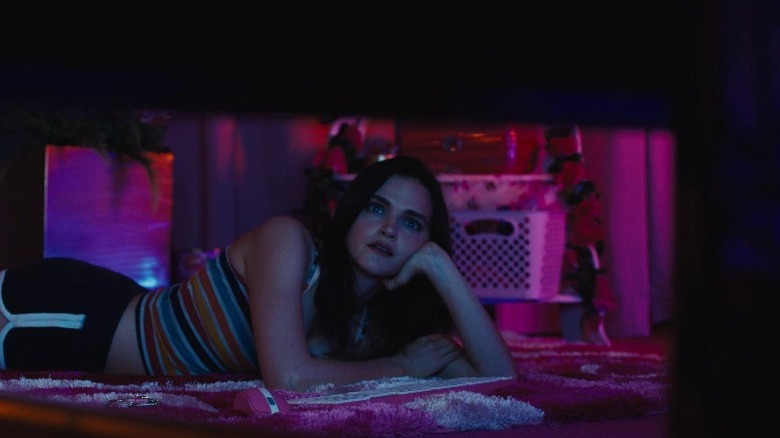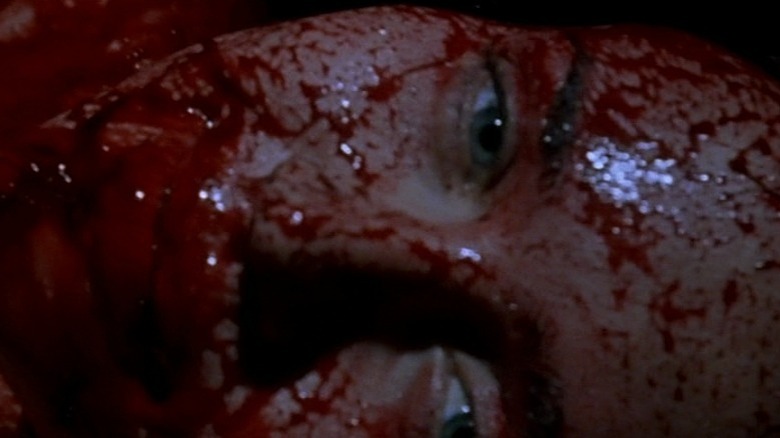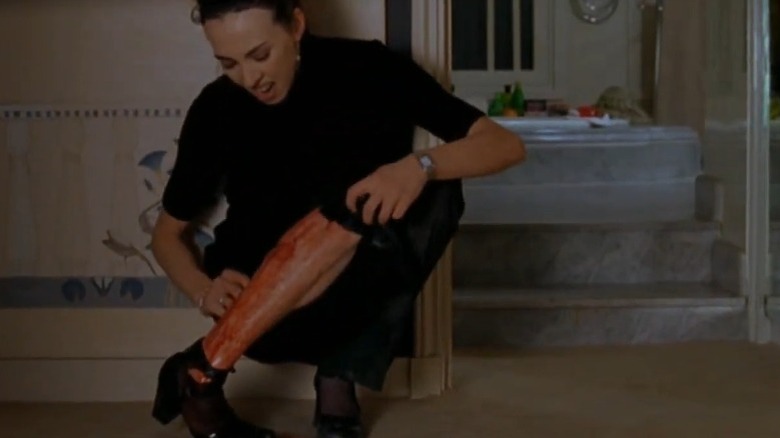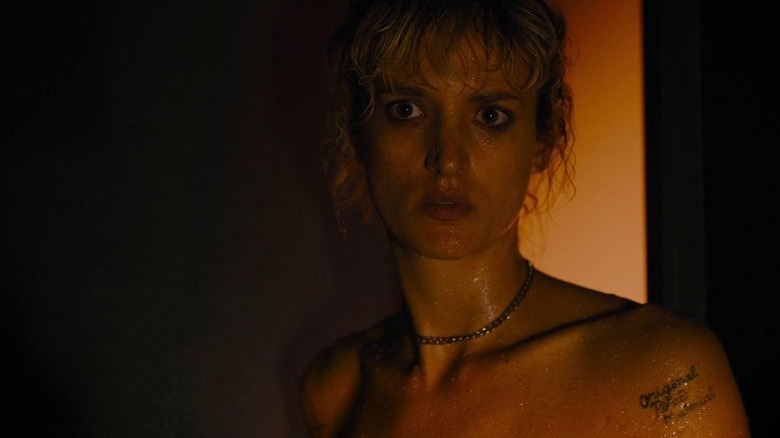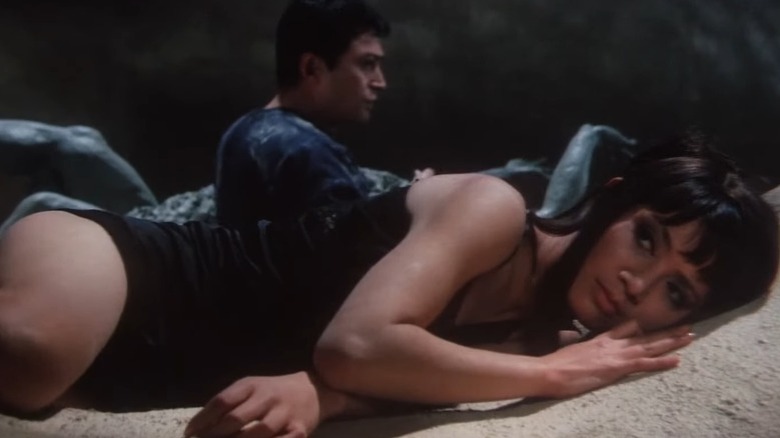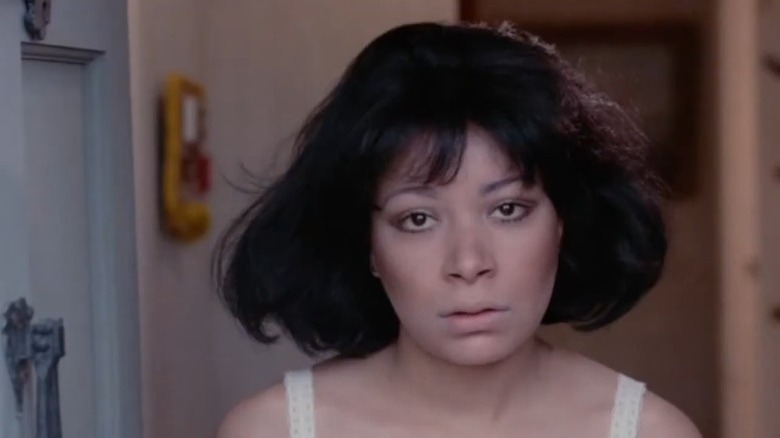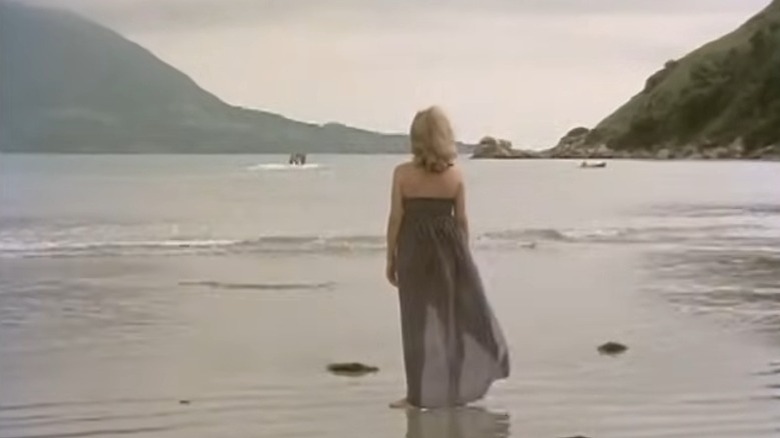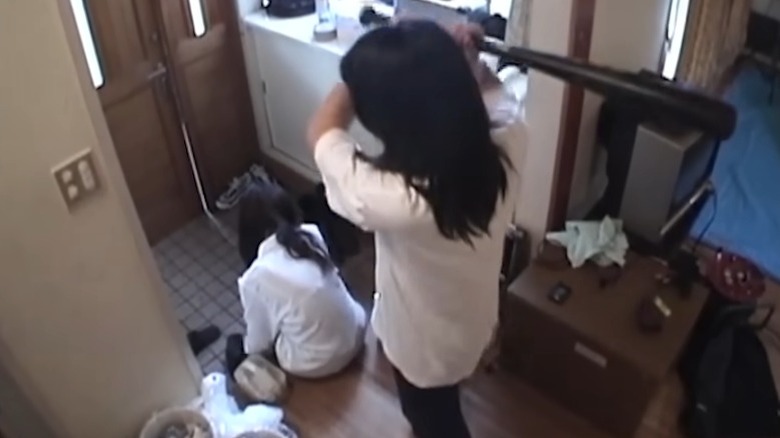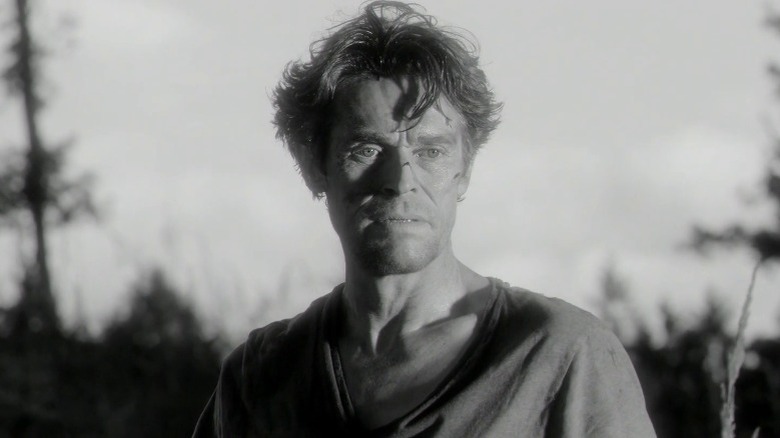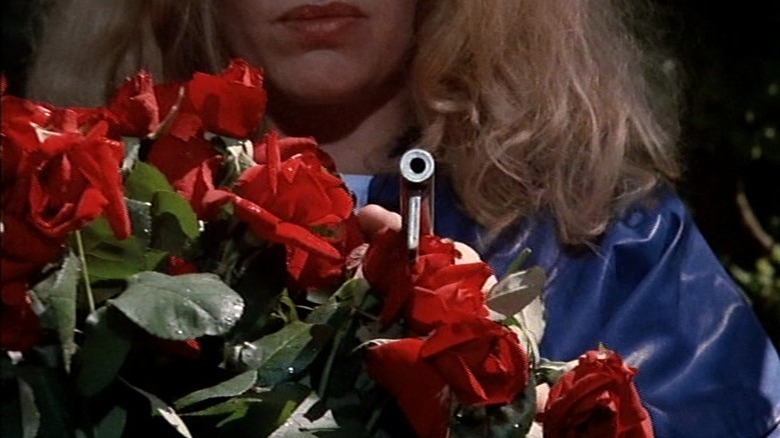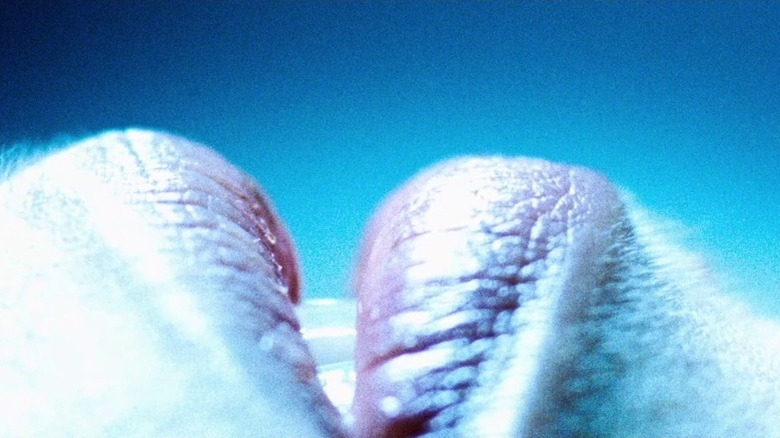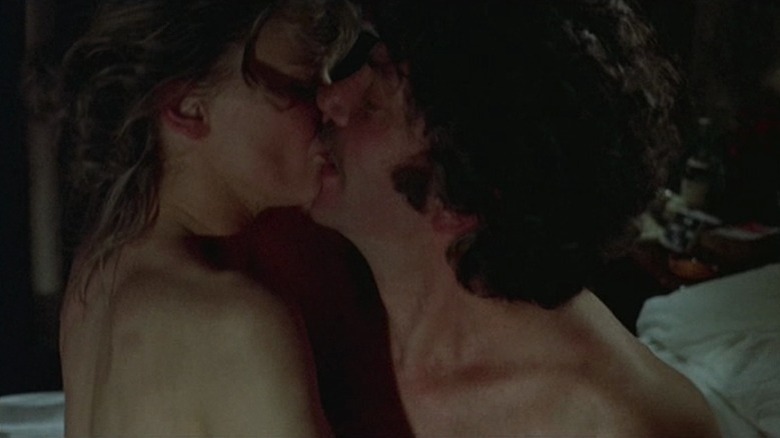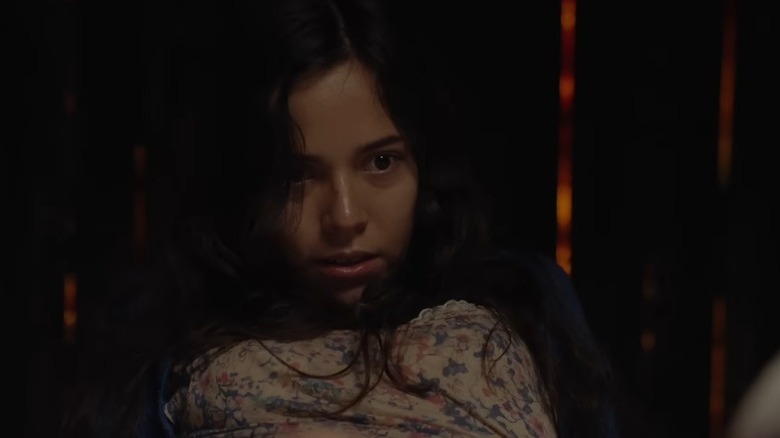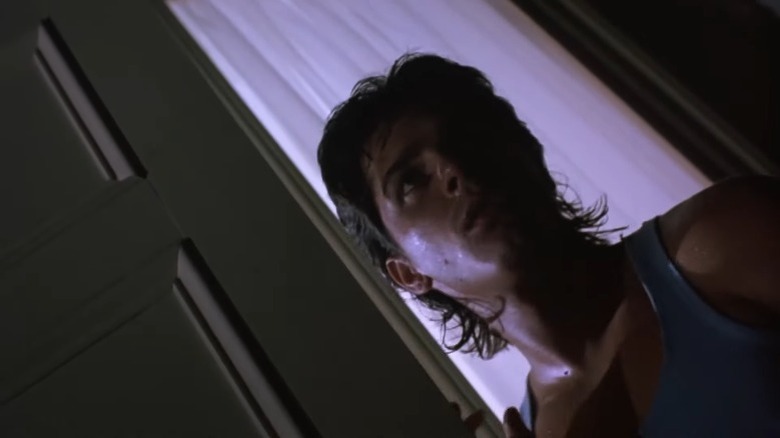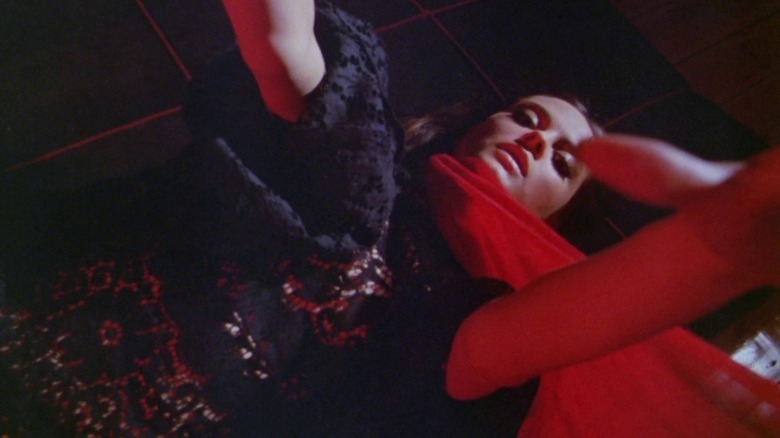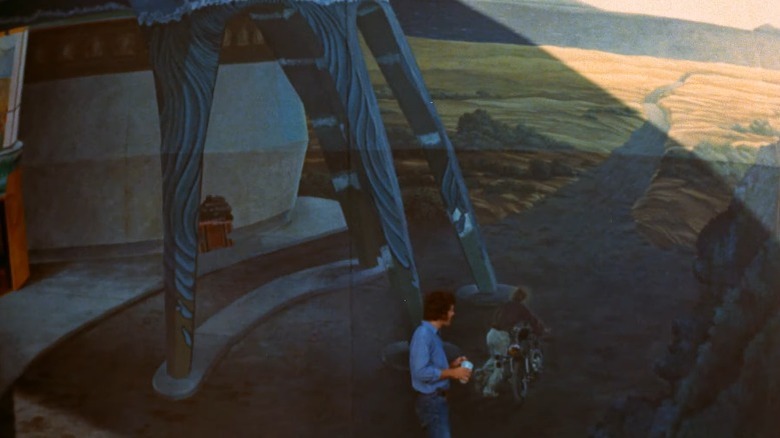Horror Movies You'd Never Want To Watch Around Your Parents
Throughout history, horror films have always been social activities — manageable mini-adventures to be experienced in kinship with a friend, a group, a date, a significant other. There's something perennially appealing about sharing a scary and disturbing movie with someone you love, seeing them react alongside you, feeling bound by a collective sense of dread, encouraging each other to shrug off the fight-or-flight instinct, and ride it out when a scene gets too horrifying. A good horror film can even bring people closer. But horror films are seldomly family events.
To be sure, there is a certain logic to watching specific horror movies with family members. The urgency of a survival adventure like "Train to Busan" or "A Quiet Place," the simmering intensity of a creature thriller like "Jaws" or "Alien," the roller-coaster-ride excitement of a game transformed into an exercise in terror in "The Conjuring," or the unspooling mysteries of a Jordan Peele or M. Night Shyamalan flick can all be enjoyed by a group of parents and their children. But horror is also a genre that deals in shock, disgust, taboo, purposeful discomfort — emotions and concepts that some might not want to contend with around their folks, especially when they're expressed through horror's similarly frequent symbiosis with trenchant sexuality.
To help avoid gaffes when planning a Halloween movie session with your family, here are 16 horror films you definitely wouldn't want to watch around your parents.
Cam
A deep, dark dive into the world of cam shows, the workers who put them on, and the cryptic technological maze where they take place, "Cam" may well be the single most underrated Netflix original movie. Although the film's depiction of camgirls' day-to-day life is refreshingly nonjudgmental and free of sensationalism, owing largely to the firsthand experience of screenwriter Isa Mazzei, its stolen-identity story gets to be utterly frightening, marking it as one of the great female doppelgänger movies.
While the film may not be as graphic or gory as other entries on this list, it still features lots and lots and lots of sex, both implied and express. In addition to performing salacious acts for her audience along with her fellow camgirls, Alice Akerman (a.k.a. Lola) is constantly having to weather the sexual appetites and demands of demeaning, invasive, and even outright cruel spectators. Thanks to Brewer's bravura performance and Daniel Goldhaber's propulsive direction, it all feels intensely authentic, intimate, and eventually terrifying.
Trouble Every Day
The only contribution of the great Claire Denis to the let's-break-every-taboo cinematic movement known as New French Extremity, "Trouble Every Day" tells the story of Shane (Vincent Gallo), an American man honeymooning with his wife June (Tricia Vessey) in Paris, who becomes obsessed with neurosurgeon Dr. Léo Sémeneau (Alex Descas) and his wife Coré (Béatrice Dalle). Coré, afflicted by an undefined craving somewhere between vampirism and compulsive cannibalism, keeps having intense sex with men and then gruesomely, animalistically killing them during the act.
If you're looking for gore, you'll find plenty in the (literally) visceral sex scenes — but neither the sex nor the violence are exactly fun. Ever the experimenter, Denis uses the film's horror elements to inquire on the instinctual, consumptive nature of desire. And, just as she always pushes her themes as far as they can be pushed, so too do the blood, sweat, and moans get pushed to appalling, nauseating heights.
In My Skin
Body horror is not the most parent-friendly subset of horror on most days, but "In My Skin" is something else entirely. Watching the film with your family may well trigger a collective emotional and existential crisis. Completely breaking down the distancing barriers that keep most body horror films safely abstract, Marina de Van's directorial debut has a simple, chillingly tangible premise: A woman (de Van) with a normal, successful life injures her leg at a party, and the wound causes her to feel an overwhelming sense of dissociation from her own body.
Soon enough, she's picking and poking at her own flesh like a curious child, and then inflicting greater and greater extremes of mutilation and disfigurement upon herself in a seemingly endless frenzy to discover what she's made of. If you can get through it all without fainting or throwing up, the movie still has a dizzying final question in store: If we are not our bodies, what are we?
Titane
To kick off the list, there's a pretty strong case to be made for "Titane" as the most twisted, upsetting, and uncomfortable film to have ever taken home the Palme d'Or at the Cannes Film Festival. Julia Ducournau's brilliantly disconcerting sophomore feature fuses body horror with outré sexual content and cultural taboos in a way rarely seen this side of Cronenberg — and decidedly unbecoming for the purposes of family movie night, even though it's about finding a family of your own.
Chronicling the roundabout self-actualization of Alexia (Agathe Rousselle), a serial killer left with an intercranial titanium plate and a lifelong vehicular obsession by a childhood car crash, the film became notorious for the shockingly explicit scene in which Alexia has sex with a Cadillac — as well as subsequent sequences depicting the bizarre and painful resulting pregnancy. Even outside those scenes, Ducournau's mastery of sex-based audience torment is unparalleled; the tiniest moments of intimacy undercut by violence in "Titane" can still make your skin crawl.
Blind Beast
A precursor to landmarks of eroticism like Nagisa Ōshima's "In the Realm of the Senses" — which would be on this list if not for the fact that it only tips into horror in the last few minutes — Yasuzo Masumura's "Blind Beast" is a masterpiece of pinku eiga, the genre of Japanese independent cinema that meshes sex and lyricism together into unique cinematic tableaux. It is also one of the great Japanese art horror films — with one genre mode blending irrevocably into the other.
Structured as a two-hander between Michio (Eiji Funakoshi), a deranged blind artist, and Aki (Mako Midori), the model he traps in his warehouse and forces to be his muse, "Blind Beast" charts paths into sexual obsession and mutually destructive sadomasochism that make "Fifty Shades of Grey" look silly. The tactility of Masumura's sex scenes is unusual even for pinku, and the denouement he concocts is guaranteed to leave any viewer flustered and horrified all at once.
A Woman's Torment
American filmmaker Roberta Findlay became known in the '70s for using the genres of exploitation and pornography as fertile grounds for psychological probing. Her singular technique came to a head in "A Woman's Torment," a 1977 film that actualizes the archetypal, "Repulsion"-esque horror narrative of the woman-gone-mad through the unfiltered lens of adult cinema.
There are both R-rated and X-rated versions of "A Woman's Torment" out there to watch, and Findlay has said she prefers the R-rated one – which still features sex aplenty, just without hardcore close-ups. The X-rated cut has its merits as well, however, with pornographic sequences that Findlay pushes towards alienating stupor in order to accentuate the mental disarray of Karen (Tara Chung), the titular tormented housewife who takes refuge in an empty beach house to avoid being sent to an asylum. In either version, Karen's downward spiral of violent hallucinations is brutal, unforgiving, unforgettable stuff.
Excitation
In the 1970s, Brazilian commercial cinema was dominated by the pornochanchada, a genre that banked on softcore sex as a draw yet waded through genres as varied as comedy, crime, melodrama, sci-fi — and, yes, horror. 1977's "Excitation," a defining work from eccentric pornochanchada master and subverter Jean Garrett, is one major example.
Focusing on a couple (Kate Hansen and Flávio Galvão) who abscond to a beach house to rebuild their life when the bustle of urbanity pushes the wife into mental disarray, only to face similar problems as she begins to hallucinate that the home appliances are coming alive, "Excitation" is Garrett's Brazilian answer to all the giallo horror films that became popular at the time – a bit less heavy on the violence, yet significantly more liberal in its attitude towards sexuality and nudity. Although the sex in the film is deliberately lacking in eroticism or audience titillation, it's no less uncomfortable to watch around one's parents.
Tumbling Doll of Flesh
Here's a movie you might never want to watch, period — but, if you do, you certainly won't want to do it in the company of a family member. A splatter film with all the revolting abandon of the genre's '70s apogee, this 1998 film from Tamakichi Anaru is among the most disturbing and stomach-churning ever made. Among pornographic films, it might take the cake.
There's a simplicity, almost a purity, to the conceit: A woman named Kana (Kanako Ooba) is hired to star in an amateur porn film. Part one, the shoot gets increasingly intense, veers into BDSM, and she tries to leave. Part two, she's tied down and tortured to death. There's not much point in listing each heinous act that the film depicts via horribly convincing gore effects and amateur-looking low-res video; if that's your thing, it will be easier to just go ahead and watch it. Suffice to say, the title is very literal.
Antichrist
Lars von Trier's films always teetered on the edge of extreme horror, but it was not until 2009's "Antichrist" that he took the full plunge. Like other films on this list, "Antichrist" is about isolation begetting violence, hallucinations, and destructive sadomasochistic fantasies, with sex scenes used as a conduit for dispiriting non-catharsis. What sets it apart is von Trier's method — brought up on the realism, baroque ornamentation, and literary thoroughness of European arthouse, he constructs a disorienting nightmare steeped in the cinematically familiar.
As such, it's a more mainstream film than some of the underground provocations on this list, with a sturdy reputation among arthouse crowds; your parents may even have already watched it. But make no mistake: This is one nasty film, in which unsimulated sex (shot with body doubles for Charlotte Gainsbourg and Willem Dafoe, for reasons that might surprise you) is used to create some of the most disturbing nude scenes ever filmed, and the term "sexual violence" is literalized in squirm-inducing sequences of genital aggression. Rarely has severe depression looked so abrasive.
The 4th Man
The title of "most inappropriate Paul Verhoeven movie to watch around your parents" has nearly as many claimants as there are Paul Verhoeven movies – even the man's blockbusters have a scuzziness to them — but "The Fourth Man," Verhoeven's only horror film, has the distinction of being a contender for his most racy and his most violent.
A pioneering film in its frank and explicit depiction of bisexuality, "The 4th Man" inhabits the full spectrum of Gerard's (Jeroen Krabbé) sexual identity, and deals very directly with the weight that Christian guilt imposes on him, in the process offering up some of the most blasphemous imagery in film history. But what really makes it a must-avoid for family movie night is the nexus that Verhoeven establishes between the sex, the guilt, and the spastic bursts of graphic violence that permeate Gerard's life and dreams as he deals with the potentially murderous Christine (Renée Soutendijk).
Amer
It's hard to even summarize the films of Hélène Cattet and Bruno Forzani, who traffic in a degree of bold experimentation and expressionism rarely seen even among arthouse auteurs. Their work is better felt than entirely "understood," and as far as feeling goes, it's hard to beat their 2009 debut "Amer," which manages the feat of being completely terrifying even as you can't quite, or can't remotely, ascertain what's going on.
Actually, there is one thing that goes on for sure and beyond all doubt: sex. A nominal giallo homage that strays too far from narrative linearity to really map faithfully to the Italian genre, "Amer" follows the childhood, adolescence, and adulthood of Ana (Cassandra Forêt, Charlotte Eugène Guibeaud, and Marie Bos), who, over the course of her life, develops a morbid feel for sexuality as a kind of sublimated death drive. Ana loses herself in violent, disturbing, and increasingly indecipherable erotic fantasies, yet Cattet and Forzani are always in full control of their macabre vision.
Don't Look Now
Arguably the film most responsible for codifying and catalyzing the so-called "elevated horror" subgenre (Ari Aster even purposely tipped his hat to it with "Hereditary"), Nicolas Roeg's "Don't Look Now" is a bonafide horror classic — though it sets upon the genre in an oblique, deliberately stalling manner that might disappoint those looking for a front-to-back scarefest. In fact, for long stretches, it's really more of a somber psychological drama about a couple (Donald Sutherland and Julie Christie) dealing with the loss of their daughter in incompatible ways; the horror of their stay in Venice only emerges bit by bit.
As parent-friendly as that description may sound, however, "Don't Look Now" is also notable for featuring a detailed five-minute sex scene between Sutherland and Christie, which ranks among the most famous of its kind. Between its length, its realism (it contains one of the earliest depictions of cunnilingus in a mainstream film), and the way it epitomizes the film's themes and expresses the couple's dynamic, it's a crucial, unskippable scene — and also makes "Don't Look Now" difficult family viewing.
The Untamed
A rare example of a horror film that managed to take home the Silver Lion for Best Director at the Venice Film Festival, Amat Escalante's "The Untamed" demonstrates the best of contemporary Mexican horror. As an entry into the storied yet somewhat out-of-style subgenre of the creature feature, it also exemplifies the variety of emotional, formal, and thematic achievement that a good monster can bring to a movie.
Even by the historically kinky standards of that subgenre, it's got an unusually sexually charged premise, which is to say a directly sexual premise, in the form of a tentacled alien creature that's incredibly good at pleasuring humans. The Atom Egoyan-esque chain of relationships and betrayals between Alejandra (Ruth Ramos), Ángel (Jesús Meza), and Fabián (Eden Villavicencio) is viciously compelling enough to watch even before Verónica (Simone Bucio) and her longtime extraterrestrial lover enter the picture. But once they do, "The Untamed" becomes one of those special horror movies where inquisitive sexual exploration and imaginative fear-mongering build continually off of each other.
Society
Brian Yuzna's "Society" made waves in 1989 for featuring unusually graphic, risqué, and creatively disturbing content by the standards of American mainstream horror. In fact, it was so unusual that it got shelved in the United States until 1992, while enjoying a healthy popularity in Europe. That cultural disparity probably came down to the film's focus on orgies as a plot point — and not only that, but incestuous orgies.
Sure, it's supposed to be scary — and, for the first 70 minutes or so, "Society" isn't much more inappropriate than an earlier '80s film like "Blue Velvet." It's not very good during that stretch, either; hardly anyone remembers the conspiracy plot about a rich boy (Billy Warlock) investigating his family's involvement in an underground ring of murderous orgies. But then comes the ending, in which Bill walks in on such an orgy himself, and "Society" delivers such a complete shock to the genre's system that Hollywood might still not have fully processed it. The less said about the supernatural fractal sexual ritual that goes on in that climax, the better. Let's just say that no American movie before or since has depicted bodies in quite the same way, and we'll leave it at that.
Vampyros Lesbos
Like many great names of exploitation cinema, Jesús Franco has devotees and detractors in more-or-less equal numbers. His sultry, atmospheric, trancelike low-budget movies are enormously fun and affecting if you're keyed in to their particular wavelength; if not, you might find yourself wishing for a "Mystery Science Theater 3000" commentary track. The most illustrative example is "Vampyros Lesbos," his 1971 masterpiece, an erotic horror film about ... well, a lesbian vampire.
In the story, Countess Nadine Carody (Soledad Miranda) is a seductive nightclub dancer who uses her act to get women's attention, and then lures them to her home. Large stretches of the film are — as they should be, this being queer horror — devoted to the sex scenes between Nadine and her lovers-slash-victims, making the film prohibitive viewing for any context in which overt eroticism isn't appropriate. But another chief point of interest is the commentary about the truly vampiric nature of male sexuality, which forms a prison from which the film's women characters are continually pushing to escape.
Hollywood 90028
The criminally little-known and underdiscussed Christina Hornisher is among the best one-and-done filmmakers of all time, and her single feature film, 1973's "Hollywood 90028," shows that she could have become one of the horror greats if she'd been able to keep working. Sad as it may be that it's the only Hornisher joint we have, "Hollywood 90028" is a stirring film about the fundamental spiritual tragedy of Los Angeles, a city haunted by dreams never fulfilled — and it uses the world of underground porn production as a window into that tragedy.
Christopher Augustine plays Mark, a man driven mad by the disparity between his dreams of Hollywood success and the reality of his soul-consuming work as a porn cameraman. Distraught and filled with rage, he becomes a serial killer with a preference for strangling young women. The film is as seedy and grimy as that logline might suggest, but even though it features plenty of sex and ugly violence like many '70s exploitation films, Hornisher's concerns lie elsewhere. She angles for a diagnosis of an entire national malaise — and pulls it off, all the way up to a harrowing final image that should have a reserved place on any serious list of the greatest closing shots ever.
